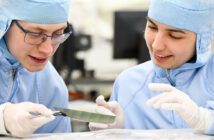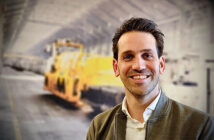Not a day goes by without something happening at Brainport Industries, the high-tech ecosystem within which the 107 – or are there already more? – suppliers that are members of the cooperative play a crucial role. John Blankendaal, Managing Director of Brainport Industries and Marc Hendrikse, CEO of NTS (and until autumn 2016 President of Brainport Industries) on the value of that southern Netherlands ecosystem.

Marc Hendrikse, NTS CEO:
‘Building machines that verge on the impossible;
that’s something we at Brainport are good at’
‘Constantly helping each other to raise the bar a little higher each time.
Marc Hendrikse is driving. ‘Yes, we are certainly busy. And the downturn in the semicon market in Asia is causing plenty of commotion. Never a dull moment.’ A good lead-in to the first question: in that volatile market, can you plan more than, say, three months ahead? ‘Not really. We do have an annual plan looking up to a year ahead, but you know when you draw it up that it’s not going to turn out that way. We develop and make products for end customers, the OEMs. If they sell more, we get to supply more. And vice versa: if their sales drop, we have to hold back. That’s the chain dynamic, and it calls for continuous tuning and planning adjustments.’
Managing the supply chain for very complex products is a big challenge, I once heard you say.
‘Yes it is. Over the past 15 years or so, the process accuracies in our customers’ machines, and hence the positioning accuracies required of us, have only increased. Whereas before we talked in terms of micrometres, we now talk in nanometres – and in the latest machines from ASML in some cases even in picometres. Those are machines that verge on the impossible. You can understand that the first version is not yet quite finished, and also that you will be hit with a flood of changes. That process of working together to constantly re-establish an equilibrium in a market that is itself volatile makes things tricky, but also challenging and fun.’
And in the Brainport ecosystem, you manage to achieve that with a very large number of players?
‘A very large number, and increasing all the time – not just firms that make stuff, but also firms that specialise in cleaning that stuff and in assuring processes. And they all have to achieve the same level at the same time. Because if one element is missing from the chain, the product won’t be right. That means we have to constantly help each other to raise the bar a little higher each time. Which is not easy, especially as there is a lot of pressure to get the product to market quickly. That increases the risk of hitting a manufacturability problem along the way – and of changes having to be made. Building a prototype is not usually the problem. The real question is, can you build one or two machines per week, at a good cost price? It’s more and more about engineering on the fly: you design a product, build it, verify that it does what it’s supposed to do and then you have to implement all kinds of changes in order to be able to manufacture the product within a regular process.’
As co-founder and former president, do you believe the Brainport ecosystem helps firms get a grip on that process?
‘Absolutely: 1) you know one another, which makes contact and coordination easier. And 2) through the meetings we hold and the projects we do together, you get a good sense of all that is going on within those complex development and manufacturing processes – and who you can do projects with. Perhaps the most important thing is that you build up trust in each other as suppliers. Which means you can work together without first having to lay everything down in contracts. The attitude is: I know you well, I know what you can do – we’ll work it out. Given the time-to-market that is expected today, that is very important: by the time you have discussed everything down to the last detail and formalised it contractually, the next change will have arrived.’
Which disciplines does Brainport need to focus on in order to remain a world leader?
‘Cleanliness, definitely. Because those accuracies are all increasing so much, you need to be top of the bill in terms of cleanliness. We also need to focus on accuracy itself, and on manufacturability. I think we Dutch high-tech suppliers have a unique combination of skills that makes us very attractive to international OEMs. At NTS, we are competing with Frencken and VDL-ETG in Singapore and China. That tells you something, doesn’t it?’

John Blankendaal, Managing Director of Brainport Industries: ‘Everything is in place to take really big strides in low volume, high complexity manufacturing industry.’ Photo: Bart van Overbeeke
John Blankendaal of Brainport Industries:
‘We have nailed the right areas to make real strides’
‘There’s been a lot of buzz here’, says John Blankendaal from his new location at the Brainport Industries Campus (BIC). The building, which measures 65,000 m2 and features an imposing entrance, is already just about full – ‘and over time we will be adding four or five more buildings at least as big’, says the Managing Director of Brainport Industries. Convincing proof that the BIC concept – encouraging innovation by bringing together parties from high-tech manufacturing industry – works.
‘We have now been active in southern Germany for three years’
Helping to deliver that mission is the ‘Factory of the Future’ innovation programme, which today numbers 65 companies and research institutes in its ranks. The seven Smart Industry field labs on campus are part of that. ‘The way to think of field labs is as experimentation environments, in which companies and research institutes, using state-of-the-art shared facilities, together take the next step in specific areas: production automation in the Flexible Manufacturing field lab, chain digitisation in The Smart Connected Supply Network field lab, and so on. At Brainport Industries, we want to be the frontrunner in Smart Industry on this campus.’
According to Blankendaal, Dutch high-tech manufacturing industry is in excellent shape seen from an international perspective. ‘I am positive about the future, although of course I would say that. But, seriously: I think we have nailed the right areas. Everything is in place to take really big strides in low volume, high complexity manufacturing industry.’
Are all links in the chain equally well represented in this region?
‘It would be good to have more large original equipment manufacturers (OEMs) in the Brainport region. That forces us to look outwards. OEMs located further away source worldwide. That’s why we have to make sure we are on their radar. Hence our internationalisation agenda. We have now been active in southern Germany for three years. There are a lot of strong high-tech companies there, not only in automotive but particularly also in medical technology. We are involved in activities with firms and business clusters in Bavaria and Baden-Württemberg which are relevant to us. That cooperation is only increasing, and it is bringing results. Take the recent acquisition of 4Plus in Erlangen by Sioux.’
Does this region have an Achilles heel?
‘Yes, the limited availability of human capital. The people in our companies are well trained – and we are doing all we can to make them even better. But we simply have too few of them, we really do have a shortage of professionals. Over the next few years, more baby boomers will be leaving the labour force than school leavers joining it – and the birth rate is so low that this will continue to be a problem in the long term if we do nothing about it. Fortunately, we are: we are working with foreign workers, with sideways recruitment and with migrants/refugees. That shortage of people is forcing us to be innovative and develop new production technology, to further automate and robotise manufacturing processes, so that fewer people are needed and the limited number of people we have can be used for the right things. We need to display creativity and common sense in dealing with this issue.’







